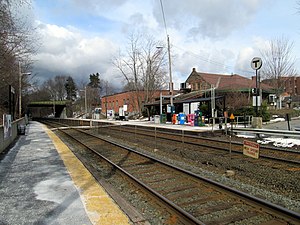Wellesley Hills station
Wellesley Hills | |||||||||||||
|---|---|---|---|---|---|---|---|---|---|---|---|---|---|
 Wellesley Hills station platforms; station building is at right | |||||||||||||
| Location | 339 Washington Street Wellesley, Massachusetts | ||||||||||||
| Coordinates | 42°18′37″N 71°16′37″W / 42.3102°N 71.2770°WCoordinates: 42°18′37″N 71°16′37″W / 42.3102°N 71.2770°W | ||||||||||||
| Owned by | MBTA | ||||||||||||
| Line(s) | Worcester Line | ||||||||||||
| Platforms | 2 side platforms | ||||||||||||
| Tracks | 2 | ||||||||||||
| Construction | |||||||||||||
| Parking | 51 spaces ($4.50 fee) | ||||||||||||
| Other information | |||||||||||||
| Fare zone | 3 | ||||||||||||
| History | |||||||||||||
| Opened | 1834 | ||||||||||||
| Rebuilt | March 13, 1886 | ||||||||||||
| Passengers | |||||||||||||
| 2018 | 336 (weekday average boardings)[1] | ||||||||||||
| Services | |||||||||||||
| |||||||||||||
| |||||||||||||
Wellesley Hills is an MBTA Commuter Rail station in Wellesley, Massachusetts. It serves the Framingham/Worcester Line. It is located off Washington Street (MA-16) in Wellesley, Massachusetts. Wellesley Hills has two low platforms serving the line's two tracks; it is not accessible. Designed in 1885 and completed in 1886, the station was the last of nine stations that H.H. Richardson designed for the Boston and Albany Railroad. It replaced a previous station, built in 1834 with the completion of the Boston and Worcester Railroad.
History[]


The Boston & Worcester Railroad (B&W), extending outwards from Boston, reached through the West Parish of Needham in mid-1834.[2] North Needham station was the terminus for a few months while construction continued towards Worcester.[3] In 1839, the line was double tracked through the area.[4]
The station was later renamed Grantvile, then briefly Nehoiden, and finally Wellesley Hills in 1881 when the West Parish was fully separated from Needham as the town of Wellesley.[3]
Wellesley Hills station was designed by Henry Hobson Richardson in 1885 for the Boston & Albany Railroad,[5] and was the last in a series of stations he designed, all featuring rough-cut light colored stone with dark stone trim around windows and doors, slate roofs, and varying amounts of decorative dark stone carvings.[5] As a B&A station, it originally served both commuter trains in the Boston Metropolitan Area and long distance trains toward Albany, New York.
By 1962, the disused station building was converted to a dry cleaning shop, with large plate glass windows added to the façade.[6] Though the platforms are still active for railroad service today, the station house is currently occupied by Caffè Nero,[7] described as a European coffee house. The portion facing the street has been renovated and the original roofing has been removed. However, the sides and back of the building have been preserved, though the windows are boarded up and large air conditioning units have been installed.[8] The previous station building, constructed in 1855, has been moved across the road and converted to a private residence.[9]
In June 2021, the MBTA issued a $28 million design contract for a project to add a third track from Weston to Framingham, including reconstruction of the three Wellesley stations and West Natick station. The project was expected to cost around $400 million, of which rebuilding Wellesley Hills station would be $43-45 million, with completion in 2030.[10]
References[]
- ^ Central Transportation Planning Staff (2019). "2018 Commuter Rail Counts". Massachusetts Bay Transportation Authority.
- ^ Humphrey, Thomas J. & Clark, Norton D. (1985). Boston's Commuter Rail: The First 150 Years. Boston Street Railway Association. pp. 21–25. ISBN 9780685412947.
- ^ a b Fiske, Joseph E.; Ellen W. Fiske (1917). History of the Town of Wellesley, Massachusetts. Boston, Chicago: The Pilgrim Press. p. 26. OCLC 6541911 – via Internet Archive.
- ^ Karr, Ronald Dale (1995). The Rail Lines of Southern New England. Branch Line Press. pp. 278–283. ISBN 0942147022.
- ^ a b # Ochsner, Jeffrey Karl, H.H. Richardson: Complete Architectural Works, MIT Press, Cambridge MA 1984
- ^ "Few Trains, But Stations Still Busy". Boston Globe. February 16, 1962. p. 24 – via Newspapers.com.
- ^ [1]
- ^ Richardson stations
- ^ Harwood, Herbert H. (Spring 1992). "History Where You Don't Expect It: Some Surprising Survivors". Railroad History (166): 103–125. JSTOR 43523701.
- ^ Kelly, Maribel (June 21, 2021). "MBTA Contract No. C72PS01: Worcester Line Track and Stations Accessibility Improvements (P0261) Design and Engineering Services" (PDF). Massachusetts Bay Transportation Authority.
External links[]
| Wikimedia Commons has media related to Wellesley Hills station. |
- Former Boston and Albany Railroad stations
- MBTA Commuter Rail stations in Norfolk County, Massachusetts
- Railway stations in the United States opened in 1885
- Richardsonian Romanesque architecture in Massachusetts
- Henry Hobson Richardson buildings
- Wellesley, Massachusetts
